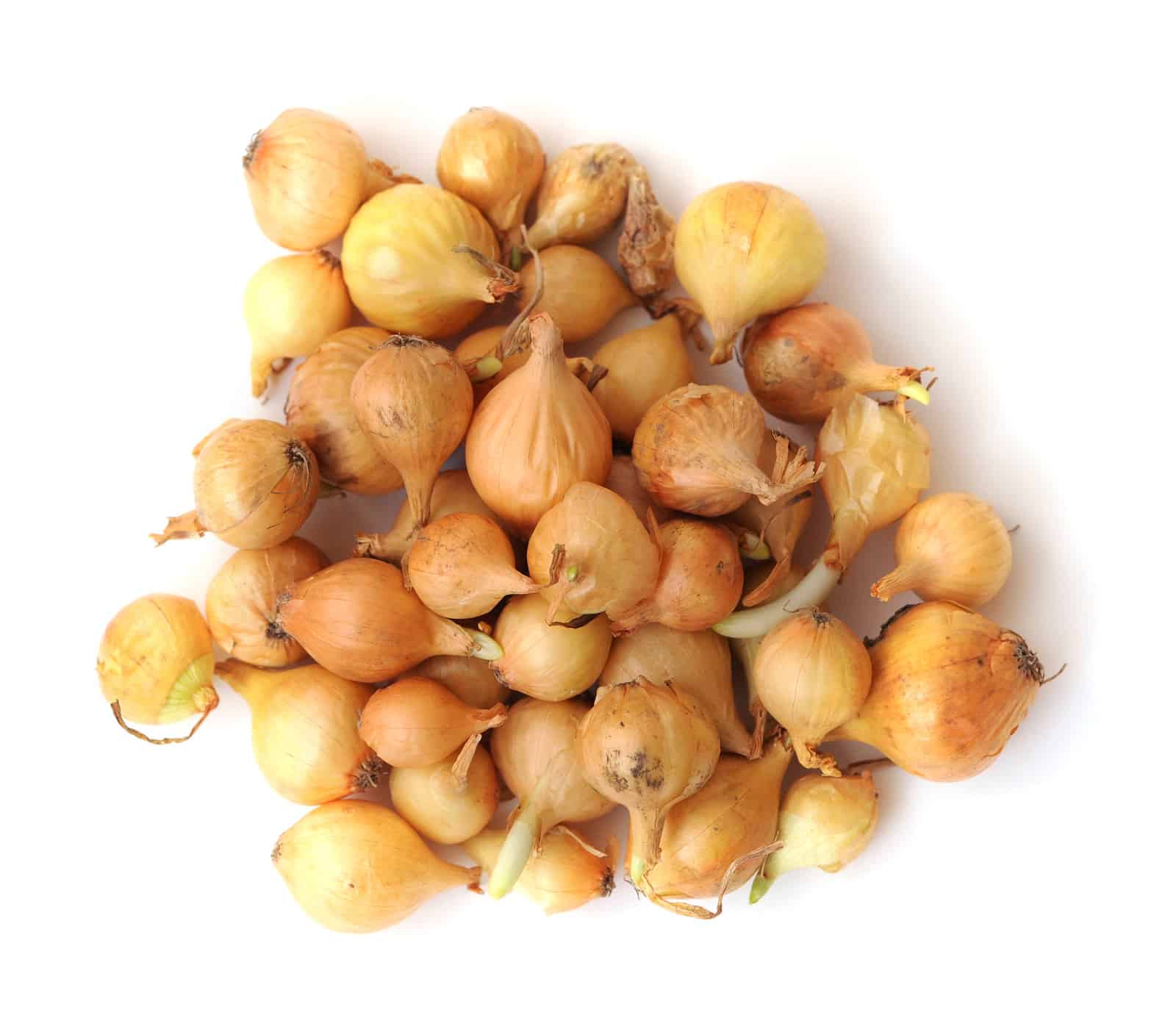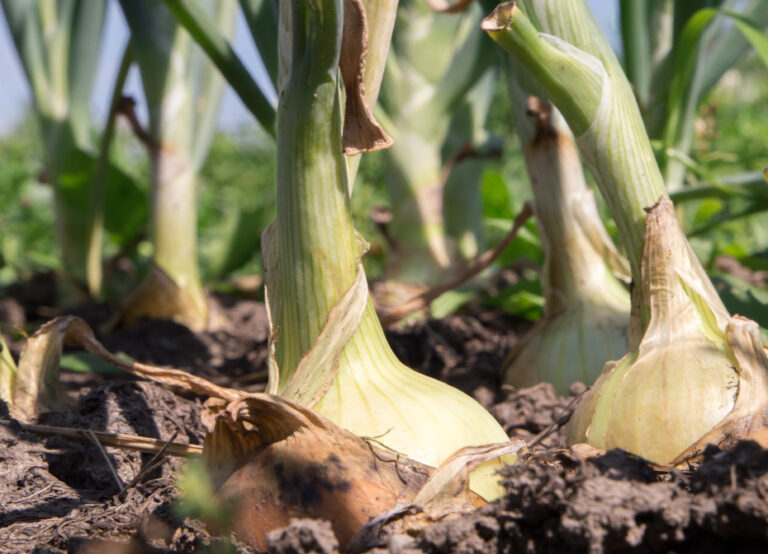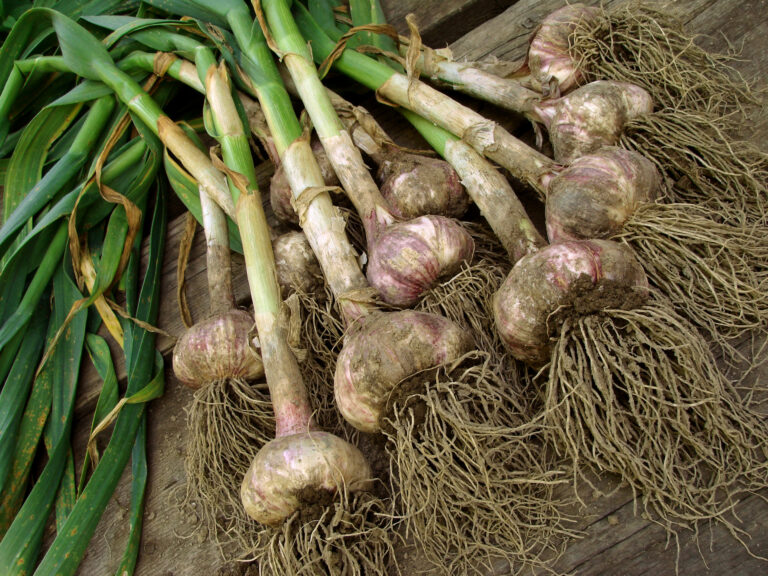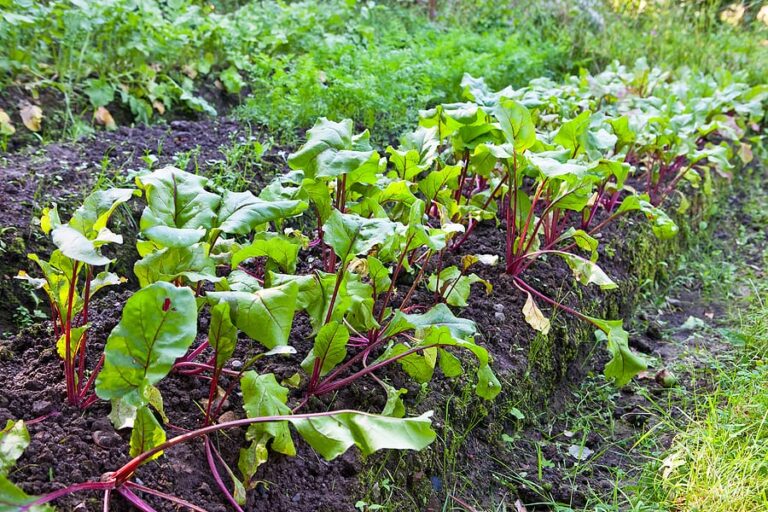How to Grow Onion Sets
Onion sets are small, dry onion bulbs grown the previous season but not allowed to mature. Grow your own onion sets from seed. It is not difficult, does not require much time, and can put you ahead in both time and money.
Planted in the second season onion sets produce an early crop of bulb onions in long-season regions—well ahead of the main crop, and in short-season regions, they produce larger onions than naturally possible.
Advantages of Growing Onions from Sets
There are several advantages to growing your own onion sets rather than buying sets from a nursery or big-box garden center. Growing your own onions sets:
- Gives you a wide range of varieties suited to your region—long-day, short-day, or intermediate day—otherwise not available. Onion sets sold in garden centers are commonly labeled by color not by variety or day length; growing from garden center sets, you often don’t know what you are growing.
- Saves you money. Onion sets are more expensive than onion seeds. A bag of 40 onion sets is more expensive than a packet of 150 onion seeds.
- Allows you to choose the size of the sets you plant; you can cull out sets that will be poor growers ensuring the crop you grow next year will be successful.
More advantages of growing onions from sets:
- Onion sets produce the earliest onions—well ahead of seed-started onions.
- Growing from onion sets saves time—40 to 60 days depending on variety; this is an important consideration if you live in a short-growing season region.
- Growing from both sets and seeds in long-season regions allows for two harvests; one early in summer and the second in late summer and fall.

Growing Onions from Seed and Sets
Onions can be grown from seeds, sets, and plants (transplants). Growing from seed is difficult for many home gardeners because onion germination rates are often poor. Sets purchased at garden centers are commonly sold as red, white, or yellow onions—the cultivar is very often not listed. Growing from plants (seedlings purchased at a nursery or garden center) is easy, but the choice of varieties offered by commercial growers can be limited.
Growing your own sets means growing from seed. But since you are growing sets for planting the following season, poor germination rates or seedling failure when growing to sets does not mean you are risking entire crop failure or poor yield from this year’s crop; rather you are growing for the future. You will plant more seeds than the sets you need; you can choose the best sets for planting next season.
How to Grow Your Own Onion Sets
- Set aside a planting bed for growing from seed. Choose a sunny location. The seed-starting bed should be compost-rich, well-drained, and free of pebbles and garden debris.
- A planting bed is a 3-foot-square bed that is big enough to grow enough sets for the following season.
- Time the sowing of sets if you like: the soil should be at least 45°F (7°C)—usually within a couple of weeks of the last frost in spring; if you sow seed for growing sets in late spring (May in the Northern Hemisphere), you can be certain the soil is warm enough and ensure plants will not develop large bulbs too large for planting next season.
- Sow the seed thickly; broadcast seeds evenly across the planting bed; this is much easier than sowing seed-by-seed. If you sow seed individually, space the seed ½ inch apart in all directions. Cover the seed lightly with ¼ to ½ inch of soil.
- Let seed germinate and grow on without thinning. Do not fertilize the seedlings; this can lead to green top growth at the expense of bulb formation.
- Bulb formation will be triggered by day length; be sure you choose a variety suitable for your region.
- Keep the planting bed just moist; do not let it go dry.
- Let the plants grow until most of the developing bulbs are ½ to ¾ inch in diameter (usually in July when the tops start to dry).
- Cull the bulbs. Do not save sets larger than 1 inch in diameter for planting next season; large sets will likely bolt and flower quickly when replanted next season. (If you do save larger sets, they can be grown as green onions next season.) Do not save sets less than ½ inch in diameter; very small sets will likely not have enough stored energy to produce large onions next season. (Take the sets you are not saving for planting next season to the kitchen.)
- A set about ¾ inch (2 cm) in diameter is ideal; it will quickly produce green onions when planted next season; if left in the ground until late summer, it will produce a good-size bulb.
- Cure the sets you are saving in a sunny place for about 10 days–until the tops dry.
- Remove the tops and store the sets in a mesh bag in a cool, dry place until planting time next spring. Be sure to label each bag.
Planted next season, sets just smaller than a nickel in diameter will develop into mature onions. Sets larger than a nickel often bolt (produce a flower stalk) and do not produce good-sized bulbs; if saved these larger sets are best used to grow green onions.
Plant sets 1 to 1½ inches deep and 2 to 3 inches apart to grow bulb onions; sets grown for green onions can be planted closer.
Onion Growing Hub
Start here: The Ultimate Onion Growing Guide: From Seed to Harvest
🌱 Planning & Varieties
- How to Choose the Best Onion Varieties for Your Region – Match flavor, storage, and climate to your garden.
- Daylength and Onion Growth: Understanding Short, Intermediate, and Long-Day Varieties – Pick the right type for your latitude.
- Growing Bulb Onions: Pick the Right Variety for Your Garden – Choose the right variety for where you live.
- Onion Sets vs. Seedlings vs. Seeds: Which Is Best for Your Garden? – Pros and cons of each planting method.
🌿 Planting & Starting
- Step-by-Step Guide to Starting Onion Seeds Indoors Successfully – Timing and troubleshooting for strong transplants.
- Planting Onions Seeds and Sets – Here’s how to get started.
- How to Grow Onion Sets – You can grow your own onion sets from seed for next year.
- Growing Onions in Containers: Soil, Pots, and Care Tips – Small-space planting success.
- How to Grow Green Onions, Spring Onions, and Scallions – Learn how these alliums differ.
- How to Plant, Grow, and Harvest Welsh Onions – Learn to grow these mild-flavored members of the onion family.
🌞 Care & Maintenance
- Watering Onions for Optimal Growth: Techniques and Tips – How much and how often to water.
- Feeding and Fertilizing Onions: Organic and Synthetic Options – Nutrient needs for strong bulbs.
- Companion Planting with Onions: Plants to Grow With and Avoid – Beneficial pairings and plants to avoid.
- Onion Family Growing Problems: Pest, Disease, and Problem Controls – Natural control of thrips, maggots, and more; identifying and treating fungal or bacterial problems.
🧅 Harvest & Storage
- How to Harvest Onions at Peak Maturity for Best Storage – Signs onions are ready and how to cure.
- How to Harvest and Store Onions – Here are the basics for harvesting and storing onions.
- Onion Storage Techniques: Keep Your Harvest Fresh for Months – Best environments for long-term keeping.
🍳 Using Your Onions
- Cooking with Onions: Recipes and Tips to Bring Out Flavor – From fresh salads to caramelized dishes.
- How to Make Onion Soup with No Recipe – Enjoy this tasty classic!
Onion articles at Harvest to Table:
How to Grow Green Onions, Spring Onions, and Scallions
Growing Onion Bulbs: Pick the Right Variety for Your Garden
How to Plant, Grow, and Harvest Welsh Onions
How to Harvest and Store Onions
Onion Family Growing Problems: Troubleshooting
Onion Cooking and Serving Tips
Tasty Ways to Cook and Serve Shallots
How to Make Onion Soup with No Recipe
How to Plant, Grow, and Harvest Shallots







